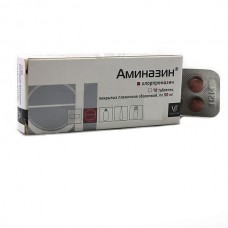Expiration date: 10/2026
Active substance: Chlorpromazine
Pharmacotherapeutic group: Antipsychotic drugs
Pharmacological properties
Pharmacodynamics: Does central adrenergic and dopaminergic receptors. It has a strong sedative effect (in comparison to other antipsychotics). Total sedation while combined with inhibition of the conditioned reflex activity, primarily motor-defensive reflexes, decreased spontaneous motor activity, relaxation of skeletal muscles, decreasing reactivity. The use of large doses causes a soporific effect. It inhibits various interoceptive reflexes, has a strong anti-emetic and protivoikotnym effects, antihistamine, and m-holinoliticheskoy prolaktinogennoy activity. It has hypothermic effect. Moderately reduces the severity of the inflammatory reaction, reduces the permeability of blood vessels, reduces the activity of kinins and hyaluronidase. Reduces systolic and diastolic blood pressure, tachycardia. It has expressed kataleptogennoe properties. The main feature is the combination of the antipsychotic chlorpromazine action with the ability to influence the emotional sphere. It relieves various types of agitation, delusions and hallucinations, fear and anxiety in patients with psychoses and neuroses.
Pharmacokinetics: The gastrointestinal tract is absorbed poorly. The maximum blood concentration reached in 2-4 hours. A significant portion is metabolized in the liver with the formation of a number of active and inactive metabolites. It has a high degree of binding to plasma proteins (95-98%). Widely distributed in the body, it penetrates the blood-brain barrier, thus its concentration in the brain than in plasma concentration. The half-life of about 30h, the elimination of metabolites is more durable. Return with urine and bile as metabolites.
Composition:
1 tablet contains 0.05 or 0.1 g of chlorpromazine hydrochloride
Excipients: tselaktoza Aerosil hydroxide (gidrargilit) aluminum, calcium stearate, stearic acid, talc, hypromellose (hydroxypropyl methylcellulose), titanium dioxide, yellow dye "sunset".
Indications for use
In psychiatry, - acute and chronic paranoid and / or hallucinatory state, agitation, including in patients with schizophrenia (hallucinatory-delusional, hebephrenic, catatonic syndromes), manic excitement in manic-depressive psychosis, agitated depression (with presenile and manic-depressive psychosis), as well as other diseases with symptoms productive and exciting. In neurology - increased muscle tone, torpid pain, persistent insomnia. As an antiemetic - Meniere's disease, pernicious vomiting in the treatment of cancer therapies, radiotherapy.
Dosage and administration
The dosage and treatment regimen set individually depending on the indication and the patient's condition. Take after meals.
In the treatment of psychiatric disorders daily dose for adults chlorpromazine ingestion of 0.3-0.6 g (1-3 doses) per day. The course of treatment - from 3 weeks to 2-4 months or longer.
In some cases, the daily dose of chlorpromazine the oral route may be increased to 0.7-1.0 g (especially in patients with chronic disease and psychomotor agitation). In this case, the daily dose is divided into 4 doses (morning, afternoon, evening and night). The duration of treatment with high doses of the drug should not exceed 1-1.5 months, with little effect it is advisable to go to the treatment of other drugs.
Debilitated patients and elderly patients administered 300 mg / day.
Higher doses for adults inside: single - 0.3 grams daily - 1,5 g
Children from 3-5 years are recommended chlorpromazine tablets of 0.025 g
When alcoholic psychosis Aminazine designate the interior of 0.2-0.4 g per day.
Side effect
Extrapyramidal disorder (parkinsonian syndrome, tremor, akathisia, indifference, slowness of reactions, blurred vision, dystonic reactions), tardive dyskinesia, depression, lower blood pressure, tachycardia, a violation of thermoregulation, dyspepsia (nausea, vomiting, constipation). Rarely - convulsions, jaundice, agranulocytosis, leukopenia, skin pigmentation, cataract, difficulty urinating, menstrual disorders, impotence, weight gain, allergic reactions (rash, swelling, photosensitivity, exfoliative dermatitis, erythema multiforme).
Contraindications
Individual sensitivity or hypersensitivity (allergy) to the drug. Severe hepatic and renal failure, progressive system of the brain and spinal cord diseases (slow neuroinfections, multiple sclerosis), traumatic brain injury, coma, decompensated heart disease, active rheumatism, thromboembolic syndrome, marked inhibition of blood, myxedema, angle-closure glaucoma. Gallstone disease and kidney stones, exacerbation of erosive and ulcerative diseases of the gastrointestinal tract, acute pyelonephritis, urinary retention with prostatic hyperplasia. Pregnancy and lactation.
Overdose
Symptoms: neuroleptic syndrome (parkinsonism, akathisia, indifference, slow response to external stimuli, long-term depression), persistent hypotension, hypothermia, coma, and later - a toxic hepatitis. Treatment: symptomatic therapy. To reduce depression prescribed central nervous system stimulants (sidnokarb). Neurological complications are reduced or cropped appointment antiparkinsonian (tsiklodol, tropatsin). When collaptoid states recommended the introduction kordiamina, caffeine, mezatona.
Features of the application
Aminazine excreted in breast milk, if you must use it during lactation, breast-feeding should be discontinued.
With extreme caution is used to treat patients with abnormal pattern of blood in the human liver, kidney, alcohol intoxication, Reye's syndrome, cancer of the breast, cardiovascular diseases, predisposition to glaucoma, Parkinson's disease, gastric ulcer and duodenal ulcers, urinary retention, chronic respiratory diseases, epileptic seizures in elderly (increasing the risk of excessive sedation and hypotensive effect), debilitated patients. Never work with the mechanisms and driving.
In the period of treatment is not allowed alcohol. In case of hypothermia should stop taking the drug. In applying the drug in patients with intestinal atony and Achille are encouraged to nominate both gastric juice or hydrochloric acid, to follow the diet and bowel functioning. Chlorpromazine in the treatment of patients should not be exposed to UV radiation due to the possibility of skin photosensitivity. With long-term treatment of drug necessary to monitor blood picture, liver and kidney function.
Interaction with other medicinal products
In an application with drugs depressing the central nervous system, as well as with ethanol or ethanol-containing preparations may increase central nervous system depression, respiratory depression, tricyclic antidepressants, maprotiline, or monoamine oxidase inhibitors - increase the risk of neuroleptic malignant syndrome, with anticonvulsants - lowering seizure threshold, with preparations for the treatment of hyperthyroidism - increased risk of agranulocytosis, with drugs that cause extrapyramidal reactions - increased frequency and severity of extrapyramidal disorders, with antihypertensive drugs - possible orthostatic hypotension with ephedrine - the weakening of the vasoconstrictor effect. Aminazine reduces the effect of cardiac glycosides, potentiates the anticholinergic effects of other drugs, with its antipsychotic effect may be reduced.
Barbiturates enhance the metabolism of chlorpromazine induce microsomal liver enzymes, and reduce its concentration in the blood. Antacids, cimetidine, antiparkinsonian agents, lithium drugs interfere with the absorption of chlorpromazine, estrogens increase its antipsychotic effects.
Tags: aminazine, chlorpromazine, buy aminazine, buy chlorpromazine




